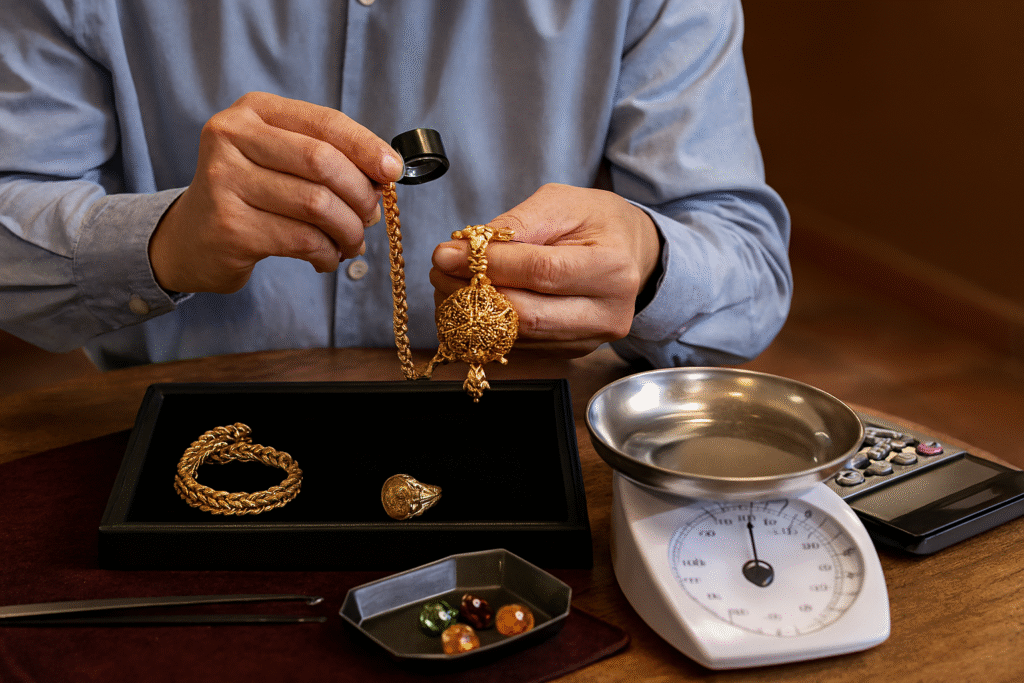Gold loan companies in Kerala have grown rapidly, offering families a quick way to access cash without selling their jewelry. But the appraisal process for a gold loan is very different from selling gold. If you understand how gold loan appraisal works, you can make smarter choices and avoid hidden costs.
Gold Loan Appraisal vs. Selling Gold
When you visit gold loan companies in Kerala, their main goal is to value your ornaments as collateral:
- Purity Check: Most lenders test purity with XRF machines. A 22K chain fetches more than an 18K one.
- Net Weight: Only the gold weight counts. Stones and enamel are excluded.
- Loan-to-Value (LTV): RBI allows a maximum of 75% of market value. For example, 20 grams of 22K gold can get you a loan equal to 75% of its value.
When you sell gold, jewelers focus on resale:
- You are paid based on live gold rates.
- Making charges may reduce the payout by 2–5%.
- Stones and gems may carry value—ignored in gold loans.
👉 The key is: Gold loan companies in Kerala value ornaments as collateral, while jewelers value them for resale.
What You Should Watch Out For
- Compare interest rates. Some firms charge 7%, others over 24%.
- Always check if weighing is done in front of you.
- Ask about foreclosure fees before pledging.
- Confirm how interest is calculated.
Case Study: Kerala’s Gold Loan Market
According to the RBI 2023 report, Kerala accounts for nearly 20% of India’s gold loan market. Muthoot Finance and Manappuram Finance are the largest players. This shows how strongly families in Kerala depend on pledged gold for financial security.
“Research shows that Kerala households hold over 400 grams of gold per capita—more than twice the national average.”
FAQ
Q1. Do gold loan companies in Kerala pay less than jewelers?
No, they don’t buy gold. They only lend against it, at 75% of its value.
Q2. Is pledged gold safe?
Yes, RBI-regulated firms insure pledged gold. If stolen, compensation is provided.
Q3. Should I pledge or sell my ornaments?
Pledge if you need short-term funds. Sell if you want full value and no repayment.
Learn about hallmarking in our guide: Understanding BIS Hallmark: What It Means for Your Jewellery
Read more on purity differences: 24K, 22K, 18K: What Every Malayali Gold Buyer Must Know
Before pledging, check our Gold Buying Checklist for Malayalis
Suggested Reading:
Reserve Bank of India – Guidelines on Gold Loans
Introduction
This comprehensive Watch Buying Guide answers the most common questions about timepieces.
Whether you’re purchasing your first watch or adding to your collection, these expert insights help you make informed decisions.
From understanding movement types to choosing the right size for your wrist, you’ll find everything needed before making a purchase.
What Types of Watches Should You Consider? – Watch Buying Guide Insights
Understanding the five main categories helps narrow your options:
- Mechanical watches – Use springs and gears. No battery needed.
- Quartz watches – Battery-powered; most accurate.
- Automatic watches – Wind themselves from wrist movement.
- Digital watches – Display time numerically on a screen.
- Smartwatches – Connect to your phone and track fitness data.
Accuracy Expectations – Watch Buying Guide Tips
- Quartz watches – Lose about 15 seconds per month.
- Mechanical watches – Lose 20–40 seconds per day.
- Atomic watches – Lose 1 second every 100 million years.
- Your phone’s clock stays perfectly accurate.
Water Resistance Considerations
Water resistance ratings affect usage scenarios:
- 30m – Handles rain and handwashing
- 50m – Safe for swimming
- 100m – Suitable for snorkeling
- 200m+ – Scuba diving
Replace gaskets every 2–3 years to maintain resistance.
Maintenance Schedule – Watch Buying Guide Advice
- Quartz watches – Battery replacement every 1–3 years.
- Mechanical watches – Full service every 3–5 years.
- Service costs: $200–800 depending on the brand.
Watch for stopping, running fast/slow, or condensation under the crystal.
Pricing Strategy
- Budget watches – Plastic cases, basic movements
- Mid-range watches – Steel cases, reliable mechanisms
- Luxury watches – Precious metals, hand-finished details
Remember: craftsmanship, materials, and brand prestige drive prices.
Sizing Advice
- 6–7 inch wrists – 38–42mm
- 7–8 inch wrists – 40–44mm
- 8+ inch wrists – 42–46mm
Ensure lugs don’t overhang wrist edges.
Complications to Prioritize
- Date display – Useful daily
- GMT hand – Second time zone
- Chronograph – Stopwatch
- Moon phase – Decorative
- Annual calendar – Adjusts month lengths
More complications = more things that can break.
Maintenance Tips
- Clean with a soft cloth
- Avoid extreme temperatures & magnets
- Wind manual watches daily
- Use watch winders for automatics
- Don’t adjust date between 9 PM–3 AM
Investment Potential
- Most watches lose value after purchase
- Only select Rolex, Patek Philippe, Audemars Piguet models appreciate
- Vintage watches from 1960s–70s show strong growth
- Buy watches you enjoy wearing, not solely for investment
Essential Tools
- Spring bar tool
- Case back opener
- Soft polishing cloth
- Watch cushion
- Demagnetizer
Where to Purchase
- Online – Better selection, often cheaper
- Physical stores – Try before buying
- Authorized dealers – Full warranties
- Grey market – Discounts, limited warranty
- Forums/eBay – Vintage pieces, verify authenticity
Learn More:

